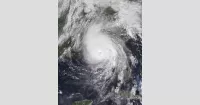Hurricane Katrina, a catastrophic tropical cyclone in late August 2005, caused 1,392 deaths and $125 billion in damages, primarily in New Orleans and surrounding areas. Tied with Hurricane Harvey as the costliest Atlantic tropical cyclone, Katrina was the twelfth tropical cyclone, fifth hurricane, and third major hurricane of the 2005 season. Its intensity made it the fourth-most intense Atlantic hurricane to make landfall in the contiguous United States based on barometric pressure.
1928: Local Cost-Sharing Required by Flood Control Act of 1928
As early as the Flood Control Act of 1928, Congress required local cost-sharing for levee work, which was the basis for the Bush administration's request in February 2008 that Louisiana pay a portion of the levee improvement costs.
1928: Flood Control Act of 1928 limits financial liability
In 1928, the Flood Control Act was established. Later, a federal appeals court ruled that the Army Corps, despite being responsible, could not be held financially liable due to the Flood Control Act of 1928.
1928: Flood Control Act of 1928 shields USACE from liability
The Flood Control Act of 1928 was cited in a January 2008 court ruling that shielded the U.S. Army Corps of Engineers from financial liability despite their role in the flooding during Hurricane Katrina.
1928: Okeechobee Hurricane
The storm surge also devastated the coasts of Mississippi and Alabama, making Katrina the deadliest hurricane since the 1928 Okeechobee hurricane
1935: Katrina Ranks Behind 1935 Labor Day Hurricane in Intensity
Hurricane Katrina was the fourth-most intense Atlantic hurricane to make landfall in the contiguous United States, behind the 1935 Labor Day hurricane.
1965: Flood Control Act tasks US Army Corps of Engineers
In 1965, Congress tasked the U.S. Army Corps of Engineers through the Flood Control Act to design and build the hurricane protection system for the region.
1965: Flood Control Act of 1965 Mandates USACE Responsibility
In 1965, the Flood Control Act mandated the U.S. Army Corps of Engineers (USACE) with the responsibility for the design and construction of the region's flood-control system.
1969: Katrina Ranks Behind Hurricane Camille in Intensity
Hurricane Katrina was the fourth-most intense Atlantic hurricane to make landfall in the contiguous United States, behind Hurricane Camille in 1969.
1985: USACE Misinterprets Study on Sheet Pile Depth
In 1985, the U.S. Army Corps of Engineers (USACE) conducted a study, the results of which were later misinterpreted, leading to the decision to use shorter steel sheet pilings in the flood walls, as mentioned in a report published in August 2015.
2004: Clinton and Bush raise funds
President Bush enlisted the help of former presidents Bill Clinton and George H. W. Bush to raise additional voluntary contributions, much as they did after the 2004 Indian Ocean earthquake and tsunami.
August 2005: Hurricane Katrina devastates New Orleans
In August 2005, Hurricane Katrina, a powerful and historic tropical cyclone, caused 1,392 fatalities and an estimated $125 billion in damages, particularly impacting New Orleans and its surrounding areas. It tied with Hurricane Harvey as the costliest tropical cyclone in the Atlantic basin.
August 19, 2005: Tropical wave merges, starting Hurricane Katrina
On August 19, 2005, Hurricane Katrina originated from the merger of a tropical wave and the mid-level remnants of Tropical Depression Ten near the Lesser Antilles.
August 23, 2005: Katrina forms as a tropical depression
On August 23, 2005, Hurricane Katrina formed from the merger of a tropical wave and the remnants of a tropical depression.
August 29, 2005: Katrina's storm surge causes breaches and flooding
On August 29, 2005, Katrina's storm surge caused 53 breaches to flood protection structures in and around New Orleans, submerging 80% of the city. The storm surge also devastated the coasts of Mississippi and Alabama, making Katrina one of the costliest natural disasters in U.S. history.
August 30, 2005: Looting and reports of violence in New Orleans
On August 30, 2005, after Hurricane Katrina moved away, some residents of New Orleans began looting stores, seeking essential items. Reports of carjacking, murders, thefts, and rapes emerged, though many were later found to be inaccurate or exaggerated.
September 2, 2005: American flags ordered half-staff
From September 2, 2005, to September 20, 2005, American flags were ordered to be flown at half-staff in honor of the victims of Hurricane Katrina.
September 3, 2005: Homeland Security Secretary describes Katrina's aftermath
On September 3, 2005, Homeland Security Secretary Michael Chertoff described the aftermath of Hurricane Katrina as "probably the worst catastrophe or set of catastrophes" in U.S. history, referring to the hurricane and the flooding of New Orleans.
September 13, 2005: India sends relief supplies to Hurricane Katrina victims
On September 13, 2005, India sent tarps, blankets, and hygiene kits to aid victims of Hurricane Katrina. An Indian Air Force IL-76 aircraft delivered 25 tonnes of relief supplies to the Little Rock Air Force Base, Arkansas.
September 20, 2005: End of half-staff flag order
September 20, 2005 marked the end date for flying American flags at half-staff, which had been ordered in honor of the victims of Hurricane Katrina since September 2, 2005.
October 23, 2005: Bodies recovered in New Orleans after levee breaches
By October 23, 2005, over 700 bodies had been recovered in New Orleans following the levee breaches caused by Hurricane Katrina. The advanced state of decomposition hindered efforts to identify many of the dead.
2005: Katrinagate controversy emerges
In 2005, the neologism "Katrinagate" was coined to refer to the controversy surrounding the government's response to Hurricane Katrina. It was a runner-up for "2005 word of the year".
January 2006: New Orleans population decline
By late January 2006, approximately 200,000 people were living in New Orleans again, which was less than half of the city's pre-storm population due to displacement from Hurricane Katrina.
February 7, 2006: Deadline set for hotel cost coverage by FEMA
February 7, 2006, marked the final deadline for FEMA's coverage of hotel costs for individuals and families displaced by Hurricane Katrina.
April 5, 2006: Army Corps of Engineers admits levee design problems
On April 5, 2006, Lieutenant General Carl Strock of the U.S. Army Corps of Engineers testified that "We have now concluded we had problems with the design of the structure", referring to the levees that failed during Hurricane Katrina.
April 2006: Name Katrina retired by World Meteorological Organization
In April 2006, the name Katrina was retired by the World Meteorological Organization due to the destruction and loss of life caused by the storm.
July 1, 2006: Louisiana shows population decline
By July 1, 2006, the U.S. Census Bureau calculated that the state of Louisiana showed a population decline of 219,563, or 4.87%, as a result of displacement from Hurricane Katrina.
2006: Tree mortality increase along the Gulf Coast
In 2006, there was a significant increase in tree mortality along the Gulf Coast, particularly in Louisiana's Pearl River Basin, where mortality rates rose to 20.5% as a result of Hurricane Katrina.
June 2007: Report indicates floodwall failures caused flooding
In June 2007, a report by the American Society of Civil Engineers indicated that two-thirds of the flooding in New Orleans was caused by failures of the city's floodwalls during Hurricane Katrina.
June 2007: American Society of Civil Engineers Report on Levee Failures
In June 2007, the American Society of Civil Engineers released a report determining that the failures of the levees and flood walls in New Orleans were primarily the result of system design and construction flaws.
January 2008: Court Rules USACE Not Liable
In January 2008, Judge Stanwood Duval of the U.S. District Court ruled that the U.S. Army Corps of Engineers (USACE) could not be held financially liable for the flooding due to sovereign immunity in the Flood Control Act of 1928, despite their role in the flooding.
February 2008: Bush Administration Requests Louisiana to Pay for Levee Work
In February 2008, the Bush administration requested that the state of Louisiana pay approximately $1.5 billion of the estimated $7.2 billion for levee work, in line with local cost-sharing principles, which angered many Louisiana leaders.
May 2, 2008: Governor Jindal Requests Levee Funding from President Bush
On May 2, 2008, Louisiana Governor Bobby Jindal requested in a speech that President Bush free up money to complete work on Louisiana's levees. Bush promised to include the levee funding in his 2009 budget but declined to include the funding in a war bill.
June 2008: Army Corps Submits MRGO De-authorization Study
In June 2008, the Army Corps of Engineers New Orleans District submitted a Deep-Draft De-authorization Study of the MRGO, stating that continued operation and maintenance of the channel was not economically justified, leading to Congress ordering its closure.
2008: Report on Katrina deaths in Louisiana
In 2008, a report by the Disaster Medicine and Public Health Preparedness journal indicated that 966 deaths could be directly attributed to Hurricane Katrina in Louisiana, with another 20 indirectly related.
2009: Publication of Catastrophe in the Making
In 2009, the book "Catastrophe in the Making" was published, suggesting that the Mississippi River-Gulf Outlet Canal's design and maintenance by the Army Corps of Engineers contributed to the flooding by allowing salt-water intrusion.
2009: Army Corps Submits Report to Congress
In mid-2009, the U.S. Army Corps of Engineers submitted a report to the U.S. Congress for consideration, planning, and response efforts related to Hurricane Katrina.
2009: Bush Promised Levee Funding in 2009 Budget
President Bush promised to include the levee funding in his 2009 budget, following a request from Louisiana Governor Bobby Jindal on May 2, 2008.
March 30, 2010: Families living in FEMA-provided trailers
As of March 30, 2010, there were still 260 families living in FEMA-provided trailers in Louisiana and Mississippi due to displacement caused by Hurricane Katrina.
2010: Debris remains in coastal communities
Even in 2010, debris remained in some coastal communities affected by Hurricane Katrina.
June 2011: Former officers appear in court for Danziger Bridge shooting
In June 2011, six former or existing police officers appeared in court relating to the Danziger Bridge shootings that occurred in the aftermath of Hurricane Katrina.
2011: Katia Replaces Katrina
In 2011, Katia replaced Katrina on the Atlantic hurricane naming lists, after Katrina was retired in April 2006.
2011: Continued tree mortality in Gulf Coast forests
Until 2011, delayed tree mortality as an effect of Hurricane Katrina continued in Gulf Coast forests, with rates up to 5%.
2014: Report revises Katrina fatality data
In 2014, a report revised the Katrina fatality data, leading to a reduction in the total number from an estimated 1,833 to 1,392, which was later updated on January 4, 2023.
August 2015: Report Published in the World Water Council Journal
In August 2015, a report published in the World Water Council journal stated that the U.S. Army Corps of Engineers misinterpreted a 1985 study. As a result of this misinterpretation, the Corps wrongly concluded that sheet piles in the flood walls needed to be driven to depths of only 17 feet instead of between 31 and 46 feet, saving US$100 million but reducing reliability.
September 2015: Study Examines Attitudes of Baton Rouge Residents Toward Newcomers
In September 2015, a study in the journal of Current Psychology examined attitudes of older, long-term residents of Baton Rouge, Louisiana toward displaced newcomers. The study suggested residents grew to become more patient and tolerant, but also more fearful and suspicious.
January 2016: Community Mental Health Journal Reveals Study on Evacuee Mental Health
In January 2016, an article published in the Community Mental Health Journal revealed information about a recent study on the psychosocial needs of Hurricane Katrina evacuees that temporarily resided in Dallas, Texas. The study revealed that more than one-fourth of the sample met the criteria for major depressive disorder.
2017: Katrina Ties with Hurricane Harvey as Costliest Cyclone
In 2017, Hurricane Katrina was recognized as tying with Hurricane Harvey as the costliest tropical cyclone on record.
2018: Katrina Ranks Behind Hurricane Michael in Intensity
Hurricane Katrina was the fourth-most intense Atlantic hurricane to make landfall in the contiguous United States, behind Hurricane Michael in 2018.
August 14, 2020: Tropical Storm Kyle Surpasses Katrina as Earliest Eleventh-Named Storm
On August 14, 2020, Tropical Storm Kyle surpassed Katrina as the earliest eleventh-named storm in the Atlantic, beating Katrina by 10 days.
September 2022: Associated Press Style Guide Change on Reporting Katrina
In September 2022, the Associated Press issued a style guide change instructing reporters to note levee failures played a major role in the devastation in New Orleans when writing about Hurricane Katrina.
January 4, 2023: NHC updates Katrina fatality data
On January 4, 2023, the NHC updated the Katrina fatality data based on a 2014 report, which reduced the total number from an estimated 1,833 to 1,392.
Mentioned in this timeline
India officially the Republic of India is a South Asian...

Hurricane Michael was an exceptionally powerful and destructive tropical cyclone...

Dallas is a major city in Texas United States and...

Books are a means of storing information as text or...

New Orleans is the most populous city in Louisiana and...
The Associated Press AP is a non-profit American news agency...
Trending
2 months ago Heavy Downpours and Strong Winds Expected to Impact Boston Commute on Monday
7 months ago US Prepares Partial Iraq Embassy Evacuation Amid Regional Security Concerns: Report

2 months ago Timothée Chalamet discusses having children, Kylie Jenner reportedly hurt by his interview comments.
1 month ago Priah Ferguson discusses girlhood, growth, Stranger Things goodbye, and Erica spinoff possibilities.

2 months ago Florence Pugh Addresses Online Abuse Regarding Zach Braff Relationship and its Impact.
3 months ago Johor Regent Seeks Sale of $2.7 Billion Singapore Land Near Botanic Gardens
Popular

Stranger Things created by the Duffer Brothers is a popular...

XXXTentacion born Jahseh Dwayne Ricardo Onfroy was a controversial yet...
The Kennedy Center Honors are annual awards recognizing individuals and...
Turning Point USA TPUSA is an American nonprofit organization founded...

Candace Owens is an American conservative political commentator and author...

Bernie Sanders is a prominent American politician currently serving as...
